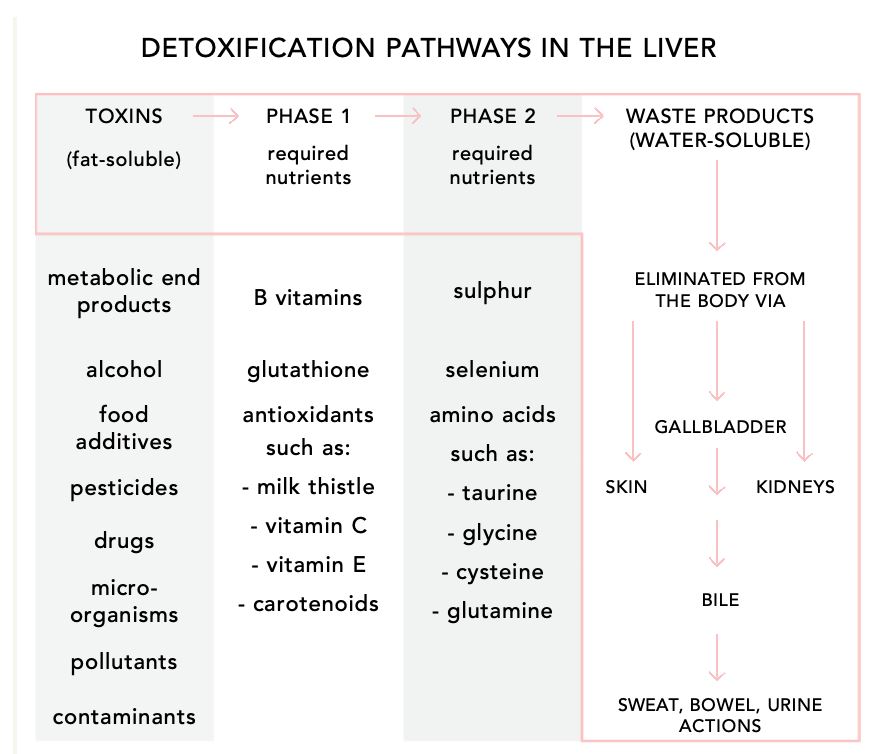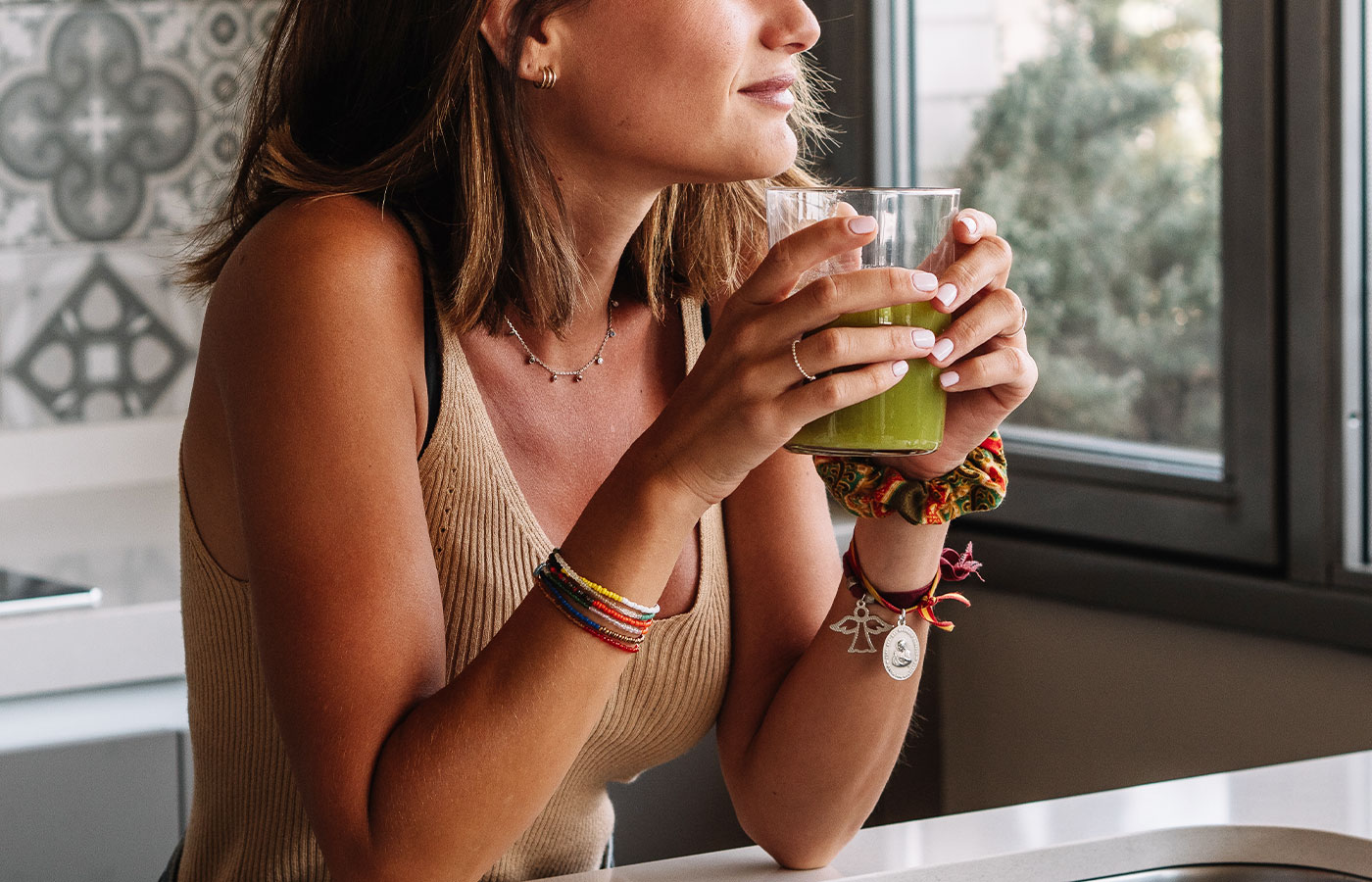The liver is the body’s second largest organ after our skin (although if you count the endothelium — the thin layer of cells that line all of the blood vessels and lymphatic vessels — as an organ the liver is the third biggest organ). It sits just behind your right ribcage and plays a host of vital roles inside you, including ones involved in the production of certain proteins and the storage of specific nutrients, like iron. Another primary role it plays is detoxification, a concept surrounded by much confusion.
Detoxification is a process that goes on inside us, all day every day, and it is essentially a transformation process in which any substance that would be harmful to you, if it were to accumulate, is changed by the liver into a less harmful form, so it can then be incorporated into your urine or faeces and excreted safely from your body. The lifestyle choices we make influence how efficiently the liver is able to do its job.
There are technically three stages to detoxification. The liver is responsible for the first two and the gut for the third. The two stages of the liver detoxification process are appropriately named phase 1 and phase 2. Both stages require certain nutrients to function, and dietary choices can influence how efficiently each phase is able to proceed.
A helpful way to picture how it works is that there are three roads into the liver (the phase 1 pathways) and six pathways out of it (the phase 2 pathways). Both phases require certain nutrients to function properly (refer to the table as a guide). Most ‘toxins’ are fat-soluble and we need to make them water soluble for elimination. Phase 1 is essentially responsible for beginning the transformation of every potentially problematic substance into a less problematic form. It requires numerous nutrients, including B vitamins which are widely on offer in many whole foods. Iron is also crucial for the phase 1 pathways to operate, yet it’s the most common nutritional deficiency in the world. After Phase 1 detoxification, the slightly transformed substance is actually momentarily more problematic, which is a major reason why optimal antioxidant consumption is important – to limit the damage this slightly changed substance could do. Phase 2 is responsible for continuing the transformation process so that the once problematic substance can safely exit the body. This phase requires specific amino acids (found in protein foods) and sulphur, in particular. We obtain dietary sulphur from eggs (the yolks), onions, garlic and shallots, as well as the Brassica family of vegetables, which includes broccoli, cabbage, kale, Brussels sprouts and cauliflower.

The liver makes enzymes that are responsible for the transformation of each substance, and the rate of production of these essential enzymes determines how quickly each substance is processed. If there are nutrient deficiencies, the amount of and the rate at which liver enzymes can be made, will be compromised. The load placed on the liver as a result of — for example — dietary choices, environmental factors, gut health and estrogen metabolism also determines how quickly things ‘move through’ the liver.
After years of regularly consuming substances found in processed foods and drinks that I refer to as ‘liver-loaders’, and/or hormonal or bowel problems, the phase 2 pathways especially, can become ‘congested’. A useful way to imagine this is like traffic on a motorway that’s banked up. Conventional blood tests for liver function do not reveal this. They look at liver damage. The liver usually takes years of battering before conventional blood tests reflect the congestion that has led to them becoming elevated (damaged) in the first place.
When the traffic is banked up (or there are unfavourable changes to the gut microbiome), there is a risk of partially detoxified substances being recycled, a process that can potentially be harmful to health. The recycled substances can’t stay in the blood though (as we are at greater risk of damage if this occurs) so the body in its infinite wisdom, stores these substances away from our vital organs, typically in body fat and bones. Not only does this increase the likelihood that body fat increases to provide more storage space, the risk of developing degenerative diseases down the track is also elevated. What organ can we take much better care of if we want to stop this recycling from happening? Our precious liver. Most people’s liver needs more support in this day and age – and less of a load – for amazing energy, vitality, efficient fat utilisation, hormone balance and healthy blood glucose regulation, just to name a few.
Some signs your liver could use some support include:
- Liver roll — body fat that protrudes from under the breasts of women, under the pectorals of men
- If your gall bladder has been removed, your liver has to make the bile on demand that the gall bladder once stored, so additional liver support is often required
- Very short fuse or temper, and this is new to you
- “Liverish,” gritty, impatient behaviour, and this is new to you
- PMS
- Overheating easily
- Itchy skin (when other conditions have been ruled out)
- “Floaters” in your vision (and iron deficiency has been ruled out)
- Waking around 2am
- Sleep which is worse on an evening you consume alcohol
- Waking hot in the night
- Not hungry for breakfast when you first get up in the morning
- Prefer to start your day with coffee
- Elevated blood cholesterol
- Estrogen-excess symptoms
- Bloat easily
- Drinking alcohol daily, or almost daily
The best way to care for your liver is through what you consume and what you omit or minimise from your way of eating. Decrease liver loaders (alcohol, trans fats, refined and artificial sugars, synthetic substances such as pesticides and non-essential medication, as well as those found in skin products). Increase bitter foods, such as leafy green vegies, particularly those in the Brassica genus such as cauliflower, broccoli, cabbage and kale. Be sure to consume plenty of other foods that contain the nutrients required for liver detoxification including protein foods for amino acids. We only have one liver. Love it accordingly.









